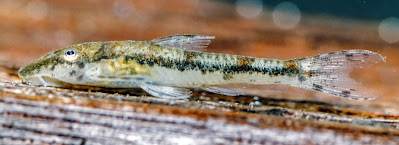 |
| Curculionichthys monolechis de Morais, Gamarra & Reis, 2024 DOI: 10.1643/i2023051 |
Abstract
A new species of Curculionichthys is described from the Saramacca and Marowijne (=Maroni) River basins in Suriname and French Guiana, eastern Guiana Shield. The new species possesses five of the seven diagnostic characteristics of the genus with the most remarkable morphological trait that distinguishes it from congeners being the presence of a single rostral plate. A genetic comparison with C. karipuna, the geographically closest species, showed a minimal distance of 5% in gene coI between individuals of the two species. The geographic distribution further extends the distribution of the genus across the Guiana Shield and represents the first species of the genus described from outside Brazil.
 |
| Curculionichthys monolechis, live coloration. Saut Tampock, Tampock River basin, Maroni drainage, French Guiana. Specimen not preserved. Image from Le Bail et al. (2000). |
Curculionichthys monolechis, new species
Etymology.— Curculionichthys monolechis is from the Greek (monos), one, single, and (lekos), plate, in reference to the single rostral plate. A noun in apposition.
Andressa de Morais, Suelen P. Gamarra, Roberto E. Reis. 2024. A New Species of Curculionichthys (Siluriformes: Loricariidae) from the Saramacca and Marowijne River Basins, Suriname and French Guiana. Ichthyology & Herpetology. 112(1):60-68. DOI: 10.1643/i2023051
Uma nova espécie de Curculionichthys é descrita das bacias dos rios Saramacca e Marowijne (=Maroni), no leste do Escudo das Guianas, no Suriname e Guiana Francesa. A nova espécie possui cinco das sete características diagnosticas do gênero, sendo a característica morfológica mais marcante que a distingue das demais congêneres a presença de placa rostral única. A comparação genética com C. karipuna, a espécie geograficamente mais próxima, mostrou uma distância mínima de 5% entre os indivíduos das duas espécies. A distribuição geográfica da espécie estende a ocorrência do gênero no Escudo das Guianas e representa a primeira espécie descrita de fora do Brasil.